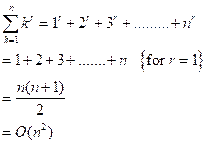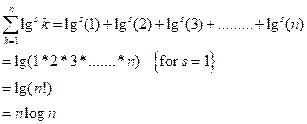
Concept explainers
To give the asymptotically tight bounds on the given summation.
Explanation of Solution
Given Information:

Calculation:
The given summation is 
Start substituting the value of  for some constant
for some constant 
After doing so, the following result can be obtained −

Therefore, the asymptotically tight bound on the  summation will be
summation will be 
To give the asymptotically tight bounds on the given summation.
Explanation of Solution
Given Information:

Calculation:
The given summation is 
Start substituting the value of  for some constant
for some constant 
After doing so, the following result can be obtained −

Therefore, the asymptotically tight bound on the  summation will be
summation will be 
To give the asymptotically tight bounds on the given summation.
Explanation of Solution
Given Information:

Calculation:
The given summation can be written as follows-

Now, substituting the values of the above summations from the part (a) and part (b).

Therefore, the asymptotically tight bound on the  summation will be
summation will be 
Want to see more full solutions like this?
Chapter A Solutions
Introduction To Algorithms, Third Edition (international Edition)
- B A E H Figure 1 K Questions 1. List the shortest paths between all node pairs. Indicate the number of shortest paths that pass through each edge. Explain how this information helps determine edge betweenness. 2. Compute the edge betweenness for each configuration of DFS. 3. Remove the edge(s) with the highest betweenness and redraw the graph. Recompute the edge betweenness centrality for the new graph. Explain how the network structure changes after removing the edge. 4. Iteratively remove edges until at least two communities form. Provide step-by-step calculations for each removal. Explain how edge betweenness changes dynamically during the process. 5. How many communities do you detect in the final step? Compare the detected communities with the original graph structure. Discuss whether the Girvan- Newman algorithm successfully captures meaningful subgroups. 6. If you were to use degree centrality instead of edge betweenness for community detection, how would the results change?arrow_forwardUnit 1 Assignment 1 – Loops and Methods (25 points) Task: You are working for Kean University and given the task of building an Email Registration System. Your objective is to generate a Kean email ID and temporary password for every new user. The system will prompt for user information and generate corresponding credentials. You will develop a complete Java program that consists of the following modules: Instructions: 1. Main Method: ○ The main method should include a loop (of your choice) that asks for input from five users. For each user, you will prompt for their first name and last name and generate the email and password by calling two separate methods. Example о Enter your first name: Joe Enter your last name: Rowling 2.generateEmail() Method: This method will take the user's first and last name as parameters and return the corresponding Kean University email address. The format of the email is: • First letter of the first name (lowercase) + Full last name (lowercase) +…arrow_forwardI have attached my code, under I want you to show me how to enhance it and make it more cooler and better in graphics with following the instructions.arrow_forward
- After our initial deployment for our ML home based security system, the first steps we took to contribute further to the project, we conducted load testing, tested and optimize for low latency, and automated user onboarding. What should be next?arrow_forwardWhy investing in skills and technology is a critical factor in the financial management aspect of system projects.arrow_forwardwhy investing in skills and technology is a critical factor in the financial management aspect of systems projects.arrow_forward
 Operations Research : Applications and AlgorithmsComputer ScienceISBN:9780534380588Author:Wayne L. WinstonPublisher:Brooks Cole
Operations Research : Applications and AlgorithmsComputer ScienceISBN:9780534380588Author:Wayne L. WinstonPublisher:Brooks Cole C++ Programming: From Problem Analysis to Program...Computer ScienceISBN:9781337102087Author:D. S. MalikPublisher:Cengage LearningProgramming Logic & Design ComprehensiveComputer ScienceISBN:9781337669405Author:FARRELLPublisher:Cengage
C++ Programming: From Problem Analysis to Program...Computer ScienceISBN:9781337102087Author:D. S. MalikPublisher:Cengage LearningProgramming Logic & Design ComprehensiveComputer ScienceISBN:9781337669405Author:FARRELLPublisher:Cengage- COMPREHENSIVE MICROSOFT OFFICE 365 EXCEComputer ScienceISBN:9780357392676Author:FREUND, StevenPublisher:CENGAGE L
 C++ for Engineers and ScientistsComputer ScienceISBN:9781133187844Author:Bronson, Gary J.Publisher:Course Technology Ptr
C++ for Engineers and ScientistsComputer ScienceISBN:9781133187844Author:Bronson, Gary J.Publisher:Course Technology Ptr Systems ArchitectureComputer ScienceISBN:9781305080195Author:Stephen D. BurdPublisher:Cengage Learning
Systems ArchitectureComputer ScienceISBN:9781305080195Author:Stephen D. BurdPublisher:Cengage Learning





